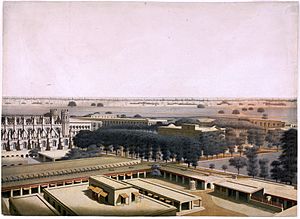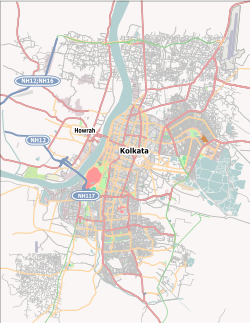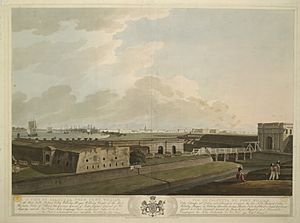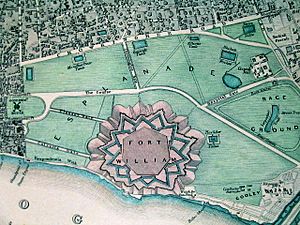Fort William, India facts for kids
Quick facts for kids Fort William |
|
|---|---|
| Kolkata, West Bengal, India | |

Fort William, seen from the inside, around 1828
|
|
| Coordinates | 22°33′28″N 88°20′17″E / 22.5577°N 88.3380°E |
| Type | Fortress, garrisoned and armoured Army Headquarters. |
| Site information | |
| Controlled by |
|
| Site history | |
| Built | 1696–1702 |
| In use | 1781–present |
| Battles/wars | Battle of Plassey (1757) |
| Garrison information | |
| Garrison | Eastern Command |
Fort William is a famous fort located in Hastings, Kolkata, India. It sits on the eastern side of the Hooghly River, a big branch of the River Ganges. This fort was built a long time ago when Britain ruled Bengal. It is one of Kolkata's most important British-era military buildings. It covers a large area of about 70 hectares.
The fort was named after King William III. In front of the fort is the Maidan, which is the largest park in India. A small guard room inside the original fort became known as the Black Hole of Calcutta. Today, Fort William is the main office for the Eastern Command of the Indian Army.
History of Fort William
There have actually been two Fort Williams. The first fort was started in 1696 by the British East India Company. Sir John Goldsborough ordered its construction. It took ten years to finish. The Mughal Emperor Aurangzeb gave permission for the fort to be built.
Sir Charles Eyre began building near the Hooghly River. He started with the South-East Bastion and its walls. The fort was named after King William III in 1700. John Beard, who took over from Eyre, added the North-East Bastion in 1701. In 1702, he started building the Government House inside the fort. The first fort was finished in 1706. It had two stories and wings that stuck out.
In 1756, the Nawab of Bengal, Siraj Ud Daulah, attacked the first Fort William. He took control of the city for a short time. He even changed its name to Alinagar. This attack made the British decide to build a new, stronger fort.
Robert Clive started building the second Fort William in 1758. This was after the Battle of Plassey in 1757, which the British won. The new fort was completed in 1781. It cost about two million pounds, which was a huge amount of money back then. The area around the new fort was cleared. This cleared land became the Maidan, often called "the Lungs of Kolkata." It stretches for about 3 kilometers long and 1 kilometer wide. The main office for the Indian Ordnance Factories was set up at Fort William in 1775.
Today, Fort William belongs to the Indian Army. It is the headquarters for the Eastern Command. It can house up to 10,000 army members. The army guards the fort very carefully. Most civilians are not allowed to enter.
Many parts of Fort William are still the same as they were. St Peter's Church, which used to be a church for British citizens, is now a library for the soldiers. A war memorial has been built at the entrance of the fort. The fort also has a museum. This museum shows items from the Indo-Pakistani War of 1971. It especially focuses on battles in the eastern part of the country and the Bangladesh Liberation War.
Fort Structure
The fort is built from brick and mortar. It has an unusual eight-sided shape. Five of its sides face the land, and three sides face the Hooghly River. The fort is designed like a star fort. This design was good for defending against old cannons that fired solid cannonballs. It was built before explosive shells were invented.
A dry moat surrounds the fort. This moat is 9 meters deep and 15 meters wide. The moat can be filled with water if needed. It is designed to allow soldiers to fire along the walls at attackers. There are six gates to the fort. These gates are called Chowringhee, Plassey, Calcutta, Water Gate, St Georges, and Treasury Gate. Similar forts can be found in places like Thalassery in Kerala.
Gallery
-
Semaphore Tower, Fort William, Kolkata
See also
 In Spanish: Fort William (Calcuta) para niños
In Spanish: Fort William (Calcuta) para niños
- Fort William College
- Fort St. George, India

















